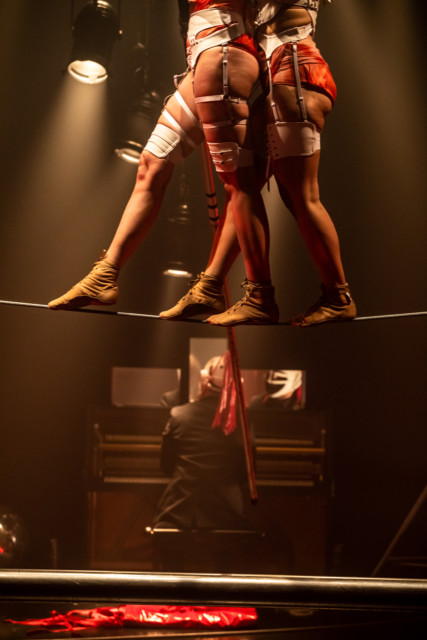Review from: Circomedia, Bristol. 5th May 2023
I wrote a Tweet after watching this latest show from Lumo Company, calling Fineline a ‘tightwire opera’. This may not be a conventional way to start a review, but Fineline is not a conventional circus show. It begins as a sort of visual art; a dynamic sculpture with bodies, wires, ropes and light, and a live soundtrack of tightenings and tunings. As the work progresses, however, it reveals itself to be more of a musical arrangement, but one composed for visual instruments as well as sonic. There are thematic elements of meaning and pop-cultural references that appear within the whole, but these are structured like movements within a concerto. Rather than the conventional dramaturgy of a circus number, based on awe, or of theatre, based on sense-making, the drama at play here feels like that of classical music, where affect and meaning emerge through aesthetic immersion and flow. If it reminds me of anything, it’s of Yablochkov Candle, a slightly older Finnish export that combined Ilona Jäntti‘s aerial artistry with musician Aino Venna‘s original sung compositions to create an atmospheric sound-sight-scape.
The usual binary tensions of body and wire harnessed by funambulists are shifted through additional ropes and angles that change the physical forces at play. Hanna Moisala and Anniina Peltovako negotiate physical suspension and balance among the ropes and rigs, while Evalds Lazarevics does the same through piano and vocals. While I didn’t expect to see aerial work incorporated into a tightwire show, its moment is completely fitting, drawing on shibari practices of self-suspension.
At the start of the show, two freestanding tightwire rigs are set, crossing each other at right angles in an X across the stage, slung with looser ropes that soften and complicate their silhouette. Behind them is an upright piano, topped with a folding vanity mirror that reflects the lines of the wires, all bathed in low red light. The three performers enter, ponytails swinging, and take their positions. Whilst the two on the wire make regular eye contact with us in the audience seats, the face of the pianist is hidden, back-turned, behind a mask and headdress. The costumes, by Riikka Manni, include feminine details of lace, masculine tailoring, and a bondage influence of straps and harnesses. They also play a fantastic trick as the lights change from red to white… And this is not the only visual trickery I experience over the show (not, of course, wanting to give the game away).
Over the course of the performance, the wire rigs and their adorning ropes are deconstructed, adjusted and manipulated in front of us, tightening, loosening, and changing the space. Not uncommon now with aerial rigging, this is still a novelty in tightwire terms. The effectiveness of simple, small wheeled platforms to adjust the orientation of the rigs is a delight.
I realise that my usual theatrical mode of observing, and trying to piece together the meaning of the show through my note-taking, isn’t right for this experience; instead I must sit back and absorb. And, as it happens, through doing this meaning does emerge over the duration. Moisala cinches her waist with coils of cable, turning slowly like a music box doll while Peltovako reclines in sensuous connection against an angled rig strut, like a slow-motion, off-kilter pole dance. A gender story develops through violence that women experience at the hands of men; a brief homage to the film Psycho; distorted figures through a curtain, balancing now on and against each other’s bodies; the piano re-injects hopeful notes, played in more melodic measures; a story of female empowerment as two women dress at their mirrors: through a shower curtain, darkly. A jaunty waltz, and now they are ready to Put On A Show. Sidestepping in tandem along the wire like a music hall duo, Moisala and Peltovako show us motifs that are familiar from the highwire acts of public imagination. But oh, I read them so differently after all that has come before!
Before the show began, I had been reflecting on the clever promotional image that looks like a film poster but, where we might usually expect to see actor’s names, instead are a series of single words based on experience and affect: ‘intense’; ‘poetic’; ‘dark’; ‘unexpected’. I haven’t been misled. And this focus on experience over semiotic meaning is refreshing. Other people may not read the same story fragments that I did through the piece and I know, for example, that a friend saw and heard religious connotations that passed me by. Fineline is not necessarily a show ‘about’ anything, other than the inherent metaphors of balance and tension underlining the disciplines presented. But that does not prevent it from being a thoughtful and thought-provoking performance, and one filled with beauty at that (shout out to the integral lighting contributions of exquisite designer Mikki Kunttu). A unique banquet for the eyes and the ears. Indeed, a tightwire opera, albeit a John Cage one.



